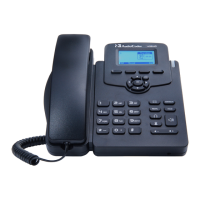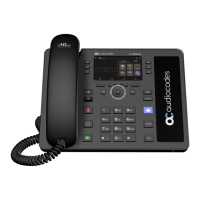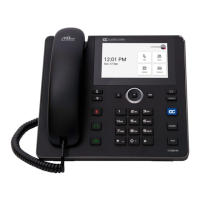400HD IP Phones Series - Teams Compatible
Administrator's Manual 36 Document #: LTRT-09960
2.1.2 Making Sure the DHCP Server is Correctly Configured for Auto
Provisioning
After creating a .cfg configuration file (see Section 2.2), place it - and the software file (img)
and other files such as tone files - on a provisioning server from where the IP phones can
download and install it.
To get the URLs to this provisioning server, the IP phones use DHCP. The provisioning
server can be HTTP/S, TFTP or FTP server.
The phone features automatic update capability to update the configuration and the software.
Checks for newer configuration files and software versions are routinely automatically
performed. Manual checks can also be performed.
To make sure the feature functions correctly:
1. Verify that the provisioning server is running and that the configuration and firmware
files are located in the correct location on it.
2. Connect the phone to the IP network and then to power.
3. On the DHCP server, configure DHCP Option 160 with the URL to the provisioning
server where the configuration and firmware files are located.
By default, the IP phone uses Option 160 which has highest priority.
If absent, the IP phone uses Options 66/67 for TFTP.
The following syntax is available for DHCP option 160:
• <protocol>://<server IP address or host name>/<firmware file
name>;<configuration file name>
• <protocol>://<server IP address or host name>
• <protocol>://<server IP address or host name>/<firmware file name>
• <protocol>://<server IP address or host name>/;<configuration file name>
Where <protocol> can be "ftp", "tftp", "http" or "https"
4. During DHCP negotiation, the phone requests DHCP options 66/67/160 to receive
provisioning information. The DHCP server responds with Option 160 providing the
provisioning URL, or Options 66 and 67 providing the TFTP IP address and firmware
file name respectively.
5. The phone then checks whether new firmware is available by checking the firmware file
header. If the version is different from the one currently running on it, the phone
downloads the complete image and burns it to its flash memory.
6. If new firmware is unavailable, the phone checks whether a new configuration file is
available on the server. If available, the phone downloads it and updates the phone’s
configuration after verifying that the configuration file is related to the phone model.
When a configuration update is needed, the phone might reboot.
Note:
• Only img (firmware) and cfg (configuration) files can be used.
• In the DHCP Discover message, the phone publishes its model name in Option
fields 60 and 77 (e.g., 450HD). To provide different provisioning information to
different models, set up a policy in the DHCP server according to phone model
name.
• If the phone is powered off during provisioning, it becomes unusable; perform a
recovery process (see Section 5 on page 175).

